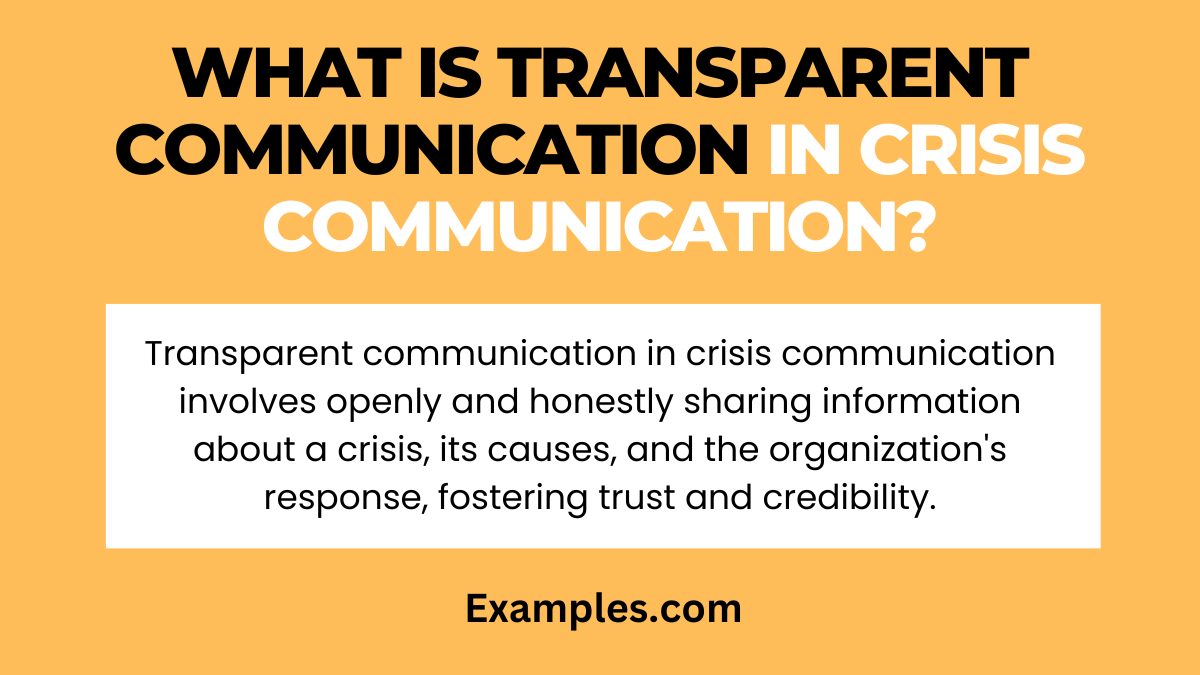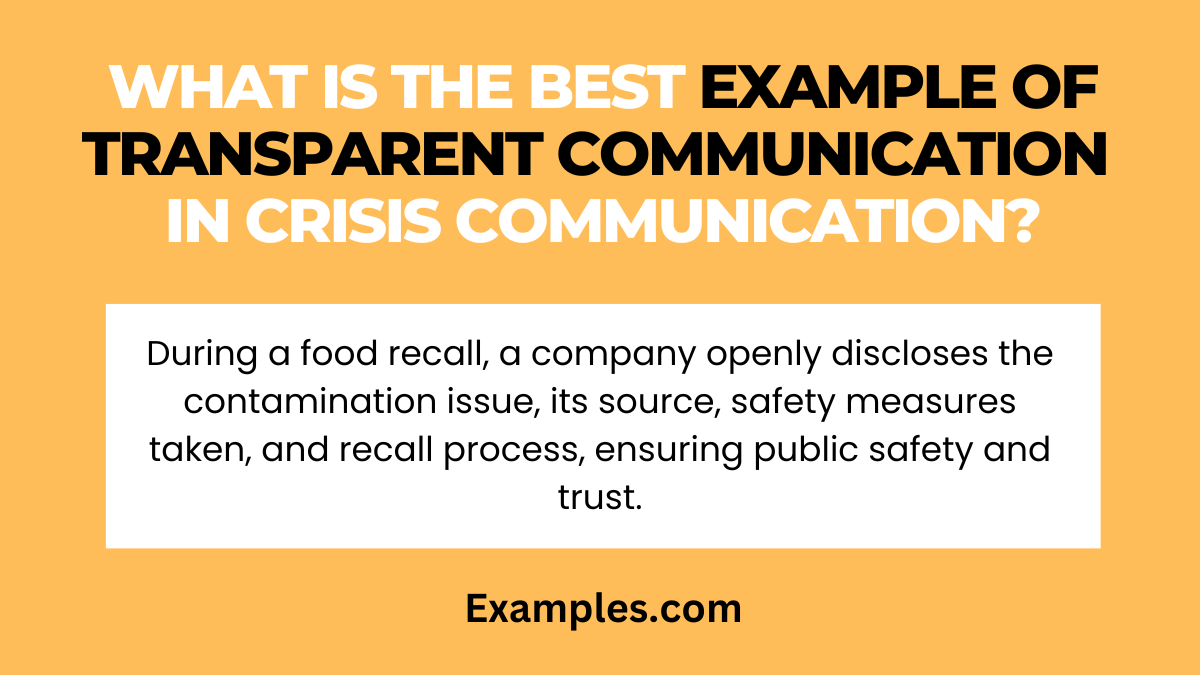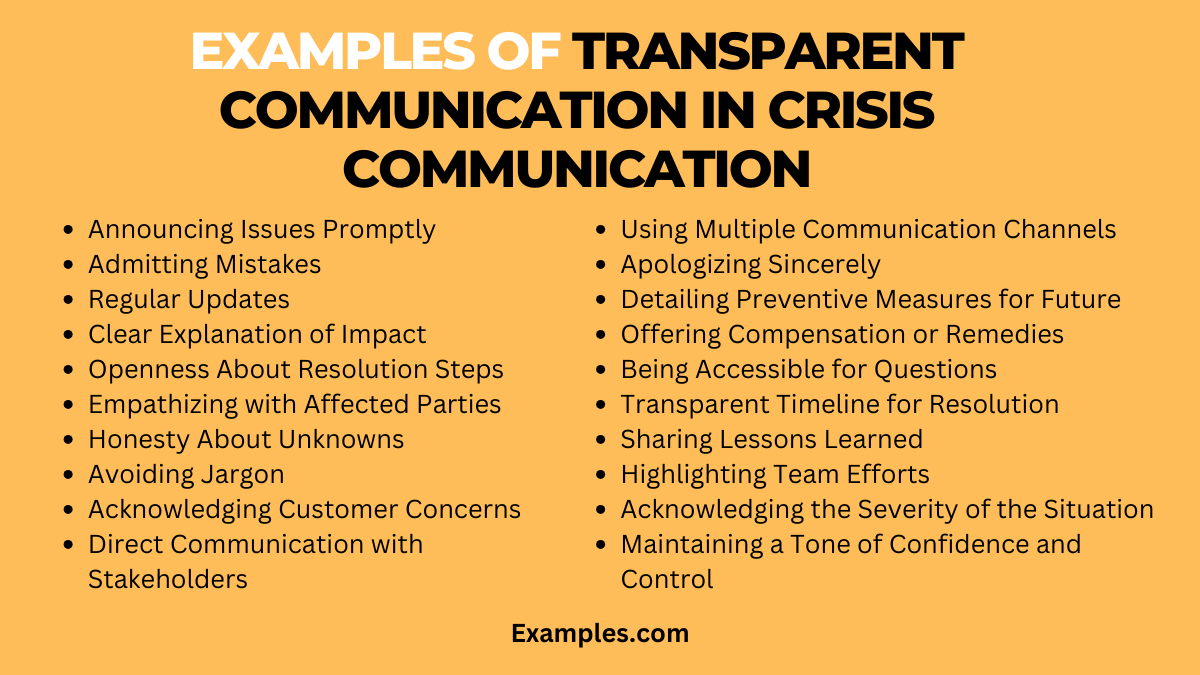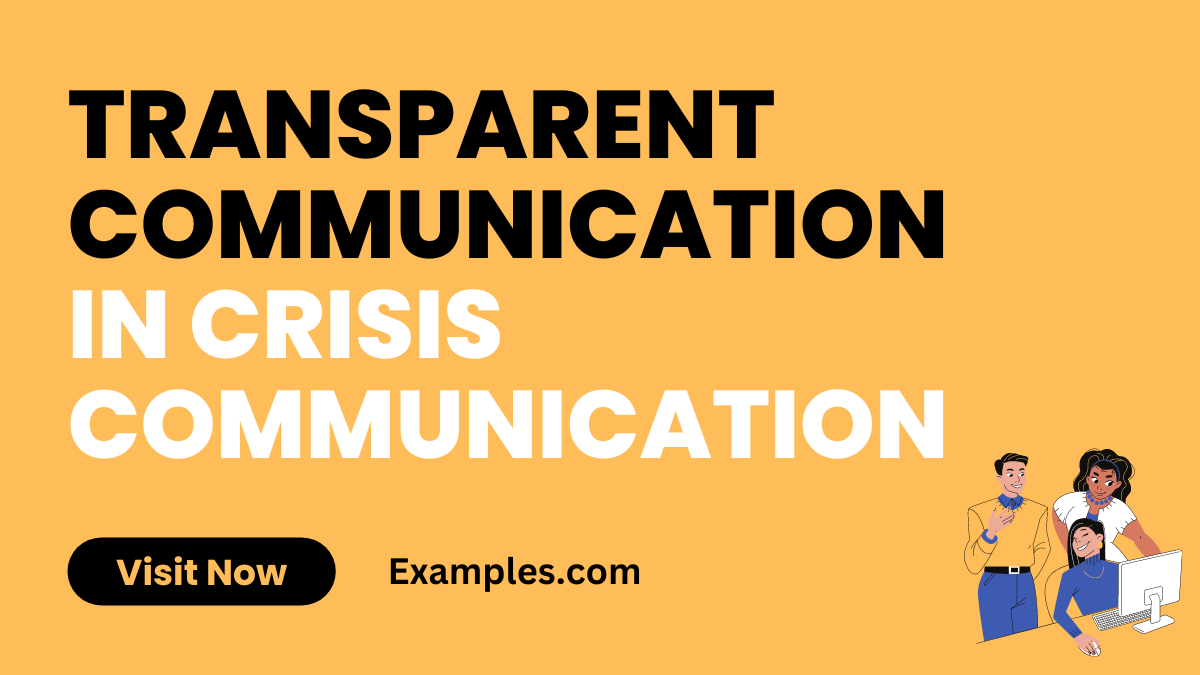19+ Transparent Communication in Crisis Communication Examples
n the realm of Crisis Communication, transparent communication stands as a cornerstone. This guide delves into the nuances of conveying clear, honest, and timely information during crisis situations. By threading through various real-life examples, it highlights the Importance of Crisis Communication and how transparency can effectively mitigate potential damages. From Rapid Response strategies to fostering trust with stakeholders, the guide covers essential facets that shape effective crisis responses.
What is Transparent Communication in Crisis Communication?

Transparent communication in Crisis Communication refers to the practice of openly and honestly sharing information with stakeholders during a crisis. It involves a commitment to factual accuracy, timely updates, and a clear message. This approach helps in building trust, reducing misunderstandings, and effectively managing the crisis situation.
What is the Best Example of Transparent Communication in Crisis Communication?

A quintessential example of transparent communication in Crisis Communication is often seen in how organizations handle public emergencies. These cases demonstrate the effective use of clear messaging, immediate updates, and factual accuracy to guide stakeholders through the crisis. One notable instance is the approach taken by a major company during a product recall, where they employed Consistent Messaging and Stakeholder Engagement to maintain public trust and efficiently resolve the situation.
20 Examples of Transparent Communication in Crisis Communication

Understanding the importance of crisis communication is pivotal in managing unforeseen challenges effectively. Transparent communication in crisis communication fosters trust and clarity, helping organizations navigate through tumultuous times. Here are 20 examples demonstrating how transparent communication can be executed, each with concise explanations and example sentences.
- Announcing Issues Promptly: “We’re currently facing technical difficulties and are actively working to resolve them. Your patience is appreciated.”
- Admitting Mistakes: “We apologize for the oversight in our recent product release and are committed to rectifying the situation.”
- Regular Updates: “We will provide hourly updates on our progress in addressing the current service outage.”
- Clear Explanation of Impact: “Due to the storm, delivery times may be delayed. We’re doing our best to minimize the inconvenience.”
- Openness About Resolution Steps: “We’ve identified the issue and our team is implementing a fix that should resolve the matter shortly.”
- Empathizing with Affected Parties: “We understand your frustration and are working tirelessly to correct this error.”
- Honesty About Unknowns: “We don’t have all the answers at this moment, but we’re investigating diligently.”
- Avoiding Jargon: “In simple terms, a technical glitch has occurred, and we’re on the path to fixing it.”
- Acknowledging Customer Concerns: “We hear your concerns about data security and assure you that safeguarding your information is our priority.”
- Direct Communication with Stakeholders: “We are directly reaching out to all affected customers with updates and solutions.”
- Using Multiple Communication Channels: “Please check our social media, website, and emails for continuous updates on the situation.”
- Apologizing Sincerely: “We sincerely apologize for any inconvenience caused and are committed to making things right.”
- Detailing Preventive Measures for Future: “We’ve implemented new procedures to prevent similar issues from occurring in the future.”
- Offering Compensation or Remedies: “As a gesture of our commitment, we’re offering affected users a one-month service credit.”
- Being Accessible for Questions: “Our customer service team is available 24/7 to answer any questions and provide assistance.”
- Transparent Timeline for Resolution: “We expect to resolve the issue by 6 PM today and appreciate your understanding.”
- Sharing Lessons Learned: “This experience has taught us valuable lessons in service reliability that we’re eager to implement.”
- Highlighting Team Efforts: “Our dedicated team is working around the clock to ensure a swift resolution.”
- Acknowledging the Severity of the Situation: “We recognize the seriousness of this issue and are treating it with the utmost urgency.”
- Maintaining a Tone of Confidence and Control: “Rest assured, we are fully equipped to handle this challenge and will keep you informed every step of the way.”
Importance of Transparent Communication in Crisis Communication
- Building Trust: Transparent communication establishes and maintains trust between an organization and its stakeholders during a crisis.
- Reducing Uncertainty: Clear and open communication helps reduce uncertainties and rumors, which can escalate the crisis.
- Enhancing Reputation: Organizations that communicate transparently are perceived as more reliable and responsible.
- Facilitating Quick Response: Transparency allows for faster decision-making and response, crucial in crisis management.
- Stakeholder Support: Open communication fosters stakeholder support and cooperation during crisis resolution.
- Legal and Ethical Compliance: Transparent communication ensures compliance with legal and ethical standards, avoiding potential legal repercussions.
- Improving Crisis Resolution: It aids in more effective crisis resolution by ensuring accurate and timely information dissemination.
- Long-Term Benefits: Maintains long-term relationships with stakeholders, essential for future organizational success.
What is the Power of Transparent Communication in Crisis Communication
- Empowering Stakeholders: It empowers stakeholders by keeping them informed and involved in crisis resolution.
- Mitigating Negative Impact: Transparent communication can mitigate the negative impacts of a crisis on an organization’s reputation.
- Promoting Consistency: Ensures consistent messaging across all channels, reducing misinformation and confusion.
- Supporting Effective Leadership: Demonstrates effective leadership and commitment to ethical practices.
- Building Resilience: Helps organizations develop resilience against future crises through learned trust and credibility.
- Fostering Employee Morale: Maintains high employee morale and loyalty by promoting an environment of honesty and openness.
- Enhancing Media Relations: Facilitates better media management and relations during a crisis.
- Guiding Post-Crisis Recovery: Plays a crucial role in the post-crisis recovery and learning process.
Phases of Transparent Communication in Crisis Communication
- Pre-Crisis Planning: Developing a transparent communication strategy before a crisis occurs.
- Initial Response: Quickly disseminating clear and factual information at the onset of a crisis.
- Ongoing Communication: Regularly updating stakeholders with new developments and corrective actions.
- Media Management: Engaging with media transparently to relay accurate information and updates.
- Stakeholder Engagement: Actively involving stakeholders in the communication process for feedback and suggestions.
- Monitoring and Adjusting: Continuously monitoring the situation and adjusting communication strategies as needed.
- Resolution and Follow-Up: Communicating the resolution of the crisis and ongoing measures to prevent future occurrences.
- Post-Crisis Evaluation: Analyzing the effectiveness of the communication strategy and making improvements for future readiness.
In mastering Crisis Communication, the key lies in embracing Transparent Communication. This approach not only fosters trust but also ensures clarity during turbulent times. By prioritizing transparency, organizations can effectively navigate the complexities of crisis scenarios, maintaining their integrity and credibility. Remember, in crisis communication, the accuracy and sincerity of your message are as crucial as its rapid dissemination. Adopting transparent strategies leads to more resilient and prepared organizations, capable of handling any crisis with poise and confidence.



